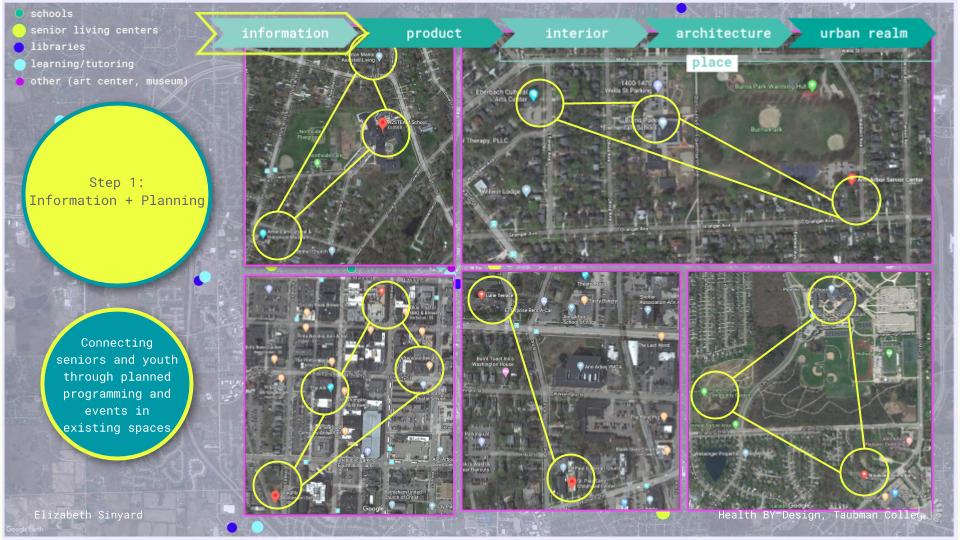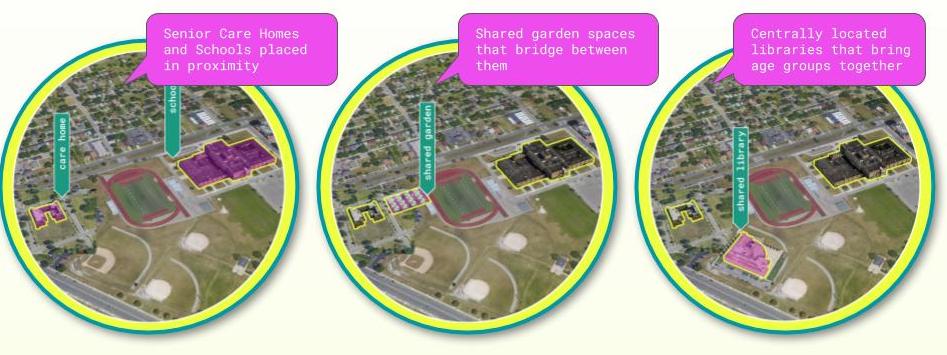︎ Spaces for Intergenerational Learning
Exploring how cities can improve mental health through designing for intergenerational mutual creation and artistic production.
By Elizabeth Sinyard ︎

To begin tackling the current issues of mental health and build a more robust community network that prioritizes intergenerational relations, community residents, organizations, designers, and city planners must all work across scales and temporalities.
Social connections must be instigated through programming as well as physical space. These spaces can take the form of shared gardens with a community kitchen, drama and performance venues, singing workshops, storytelling events, art classes, training in various forms of media and many more. These programs all allow for shared goals, mutual creation and the transferal of knowledge by both groups.

Step 1: Information + Planning / 2020
By bringing different populations within the community together, particularly youth and seniors, and instigating new relationships, activities, abilities, and appreciation for each other, feelings of isolation and loneliness can quickly decrease and more members of the community can feel a sense of belonging, value, and purpose. To achieve this outcome, I propose three sequential steps that can be instigated at different scales over time to generate positive and healthy change for communities:
- Information: Map some of the most frequented locations of both younger and older city residents (i.e. schools,
care homes, libraries, etc.). Proximate relationships to each other and to existing cultural/artistic space will become evident. (see above photo)
- Interior/Architecture: Assess the map of schools and care homes to determine where they exist beyond the accessible distance and determining a building or space that could be designed or converted into an environment for intergenerational activity. The design and retrofitting of these spaces must take into account the spatial characteristics necessary to cater to the learning of both age groups and enhance engagement between participants.
- Urban Scale: Intergenerational activity must be a priority and a goal across sectors. Health care, the public housing authority, community-based organizations, philanthropy, city officials, and planners must partner together to successfully plan urbanisms that allow for and promote intergenerational connection.


Design to Outcomes
These designed environments promote intergenerational mutual creation and transfer of experiences. Outcomes include stronger social connections, new abilities/skills, decreased loneliness, greater respect for each other/self, improved mental health & wellbeing, and most robust community networks.
︎
Works Cited
Beynon, C., & Lang, J. (2018). The More We Get Together, The More We Learn: Focus on Intergenerational and Collaborative Learning Through Singing. Journal of Intergenerational Relationships, 16(1–2), 45–63. https://doi.org/10.1080/15350770.2018.1404405
Center For Disease Control and Prevention. (n.d.). https://www.cdc.gov/
Gallagher, C., & Fitzpatrick, A. (2018). “It’s a Win-Win Situation” – Intergenerational Learning in Preschool and Elder Care Settings: An Irish Perspective. Journal of Intergenerational Relationships, 16(1–2), 26–44. https://doi.org/10.1080/15350770.2018.1404403
Jos Boys. (2011). Towards Creative Learning Spaces. Routledge. https://books.google.com/books?hl=en&lr=&id=wxSsAgAAQBAJ&oi=fnd&pg=PP1&dq=designing+learning+spaces+for+mental+health&ots=Vi4GkrjvP2&sig=YR4nbnd9OXqWz37sL6AgV9P2i7o#v=onepage&q=designing learning spaces for mental health&f=false
Loewen, J., & (U.S.), E. R. I. C. (1996). Intergenerational Learning What If Schools Were Places Where Adults and Children Learned Together? In Intergenerational Learning What If Schools Were Places Where Adults and Children Learned Together? (Issue [S.l.] :). Distributed by ERIC Clearinghouse. http://files.eric.ed.gov/fulltext/ED404014.pdf
Reva Nandakumara. (2017). Experiences of Being. The Beth Johnson Foundation. TOY. (n.d.). TOY Pilot Actions: Summary of the main trends and most interesting findings. 1–4. http://www.toyproject.net/wp-content/uploads/2016/10/TOY-Pilot-Actions_summary-24-Nov-14.pd
World Health Organization. (n.d.). https://www.who.int/